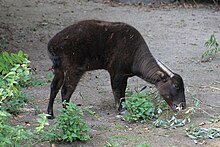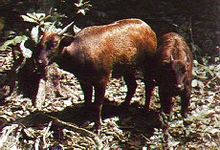
Anoa, also known as dwarf buffalo and sapiutan, are two species of the genus Bubalus, placed within the subgenus Anoa and endemic to the island of Sulawesi in Indonesia: the mountain anoa and the lowland anoa. Both live in undisturbed rainforest and are similar in appearance to miniature water buffaloes, weighing 150–300 kg (330–660 lb).

The bongo is a large, mostly nocturnal, forest-dwelling antelope, native to sub-Saharan Africa. Bongos are characterised by a striking reddish-brown coat, black and white markings, white-yellow stripes and long slightly spiralled horns. It is the only tragelaphid in which both sexes have horns. Bongos have a complex social interaction and are found in African dense forest mosaics. They are the third-largest antelope in the world.

The water buffalo, also called the domestic water buffalo or Asian water buffalo, is a large bovid originating in the Indian subcontinent and Southeast Asia. Today, it is also found in Italy, the Balkans, Australia, North America, South America and some African countries. Two extant types of water buffalo are recognized, based on morphological and behavioural criteria: the river buffalo of the Indian subcontinent and further west to the Balkans, Egypt and Italy and the swamp buffalo, found from Assam in the west through Southeast Asia to the Yangtze valley of China in the east.

Bovines comprise a diverse group of 10 genera of medium to large-sized ungulates, including cattle, bison, African buffalo, water buffalos, and the four-horned and spiral-horned antelopes. The evolutionary relationship between the members of the group is still debated, and their classification into loose tribes rather than formal subgroups reflects this uncertainty. General characteristics include cloven hooves and usually at least one of the sexes of a species having true horns. The largest extant bovine is the gaur.

Bubalus is a genus of Asiatic bovines that was proposed by Charles Hamilton Smith in 1827. Bubalus and Syncerus form the subtribe Bubalina, the true buffaloes.

The tamaraw or Mindoro dwarf buffalo is a small buffalo belonging to the family Bovidae. It is endemic to the island of Mindoro in the Philippines, and is the only endemic Philippine bovine. It is believed, however, to have once also thrived on the larger island of Luzon. The tamaraw was originally found all over Mindoro, from sea level up to the mountains, but because of human habitation, hunting, and logging, it is now restricted to only a few remote grassy plains and is now a critically endangered species.
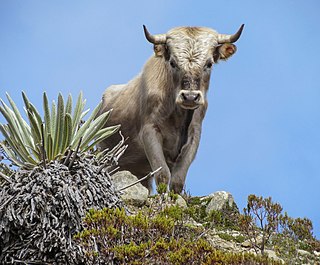
A feral animal or plant is one that lives in the wild but is descended from domesticated individuals. As with an introduced species, the introduction of feral animals or plants to non-native regions may disrupt ecosystems and has, in some cases, contributed to extinction of indigenous species. The removal of feral species is a major focus of island restoration.

The Celebes warty pig, also called Sulawesi warty pig or Sulawesi pig, is a species in the pig genus (Sus) that lives on Sulawesi in Indonesia. It survives in most habitats and can live in altitudes of up to 2,500 m (8,000 ft). It has been domesticated and introduced to a number of other islands in Indonesia.
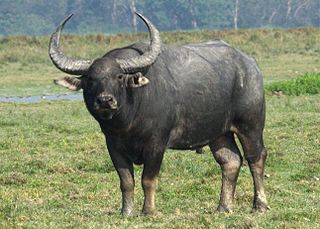
The wild water buffalo, also called Asian buffalo, Asiatic buffalo and wild buffalo, is a large bovine native to the Indian subcontinent and Southeast Asia. It has been listed as Endangered in the IUCN Red List since 1986, as the remaining population totals less than 4,000. A population decline of at least 50% over the last three generations is projected to continue. The global population has been estimated at 3,400 individuals, of which 3,100 (91%) live in India, mostly in Assam. The wild water buffalo is the most likely ancestor of the domestic water buffalo.

The tribe Bovini, or wild cattle, are medium to massive bovines that are native to Eurasia, North America, and Africa. These include the enigmatic, antelope-like saola, the African and Asiatic buffalos, and a clade that consists of bison and the wild cattle of the genus Bos. Not only are they the largest members of the subfamily Bovinae, they are the largest species of their family Bovidae. The largest species is the gaur, weighing up to 1,500 kg (3,300 lb).

The Siau Island tarsier is a species of tarsier from the tiny volcanic island of Siau in Indonesia. The T. tumpara species is one of 14 species and 7 subspecies in the tarsier family called "Tarsiidae". They belong to the Haplorrhini suborder, known as the "dry-nosed" primates. The tarsier's eyes are so big that they do not move in its socket and they are almost as big as its brain. The name tumpara, which means tarsier in the local language of Sulawesi, was an attempt to encourage the community in preserving this biological heritage.
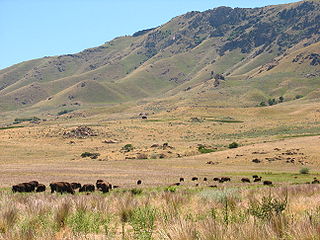
The Antelope Island bison herd is a semi–free-ranging population of American bison in Antelope Island State Park in Great Salt Lake, Utah. Bison were introduced to Antelope Island in 1893. The herd is significant because it is one of the largest and oldest publicly owned bison herds in the nation. The Antelope Island bison herd currently numbers between 550 and 700 individuals. Though the bison on Antelope Island are Prairie bison, which was the most common bison subspecies in North America, the bison have a distinct genetic heritage from many of the other bison herds in the United States and they are considered to be desirable as part of the breeding and foundation stock for other bison herds, because of their separate genetic heritage and some of the distinct genetic markers that are found in the population.

The Yellowstone bison herd is a bison herd in Greater Yellowstone Ecosystem. It is probably the oldest and largest public bison herd in the United States, estimated in 2020 to comprise 4,800 bison. The bison are American bison of the Plains bison subspecies. Yellowstone National Park may be the only location in the United States where free-ranging bison were never extirpated, since they continued to exist in the wild and were not reintroduced.
The Henry Mountains bison herd, numbering 250 to 400 American bison, is one of only four free-roaming bison herds on public lands in North America. The other three herds are the Yellowstone bison herd which was the ancestral herd for the Henry Mountains animals, the Wind Cave bison herd in South Dakota and the herd on Elk Island in Alberta, Canada.

Tangkoko Batuangus Nature Reserve, Indonesian: Tangkoko-Batuangus Dua Saudara is a nature reserve in the northern part of Sulawesi island of Indonesia, 70 kilometres from Manado City. The reserve covers an area of 8,718 hectares, and includes three mountains: Mount Tangkoko at 1,109 metres, Mount Dua Saudara at 1,361 metres, and Mount Batuangus at 450 metres.

The lowland anoa(Bubalus depressicornis) is a species of buffalo endemic to Sulawesi. Its closest relative is the mountain anoa, and it is still a debate as to whether the two are the same species or not. It is also related to the water buffalo, and both are classified in the genus Bubalus.
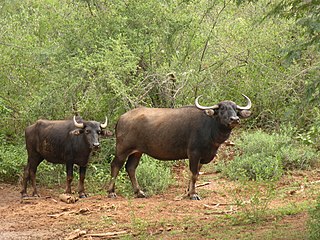
Bubalina is a subtribe of wild cattle that includes the various species of true buffalo. Species include the African buffalo, the anoas, and the wild water buffalo. Buffaloes can be found naturally in sub-Saharan Africa, South Asia and Southeast Asia, and domestic and feral populations have been introduced to Europe, the Americas, and Australia. In addition to the living species, bubalinans have an extensive fossil record where remains have been found in much of Afro-Eurasia.

The Sulawesi lowland rain forests is a tropical moist forest ecoregion in Indonesia. The ecoregion includes the lowlands of Sulawesi and neighboring islands.

The Sulawesi montane rain forests is a tropical moist forest ecoregion in Indonesia. It includes the highlands of Sulawesi.
Bubalus grovesi is an extinct species of water buffalo that lived in southern Sulawesi during the Late Pleistocene and Early Holocene.
